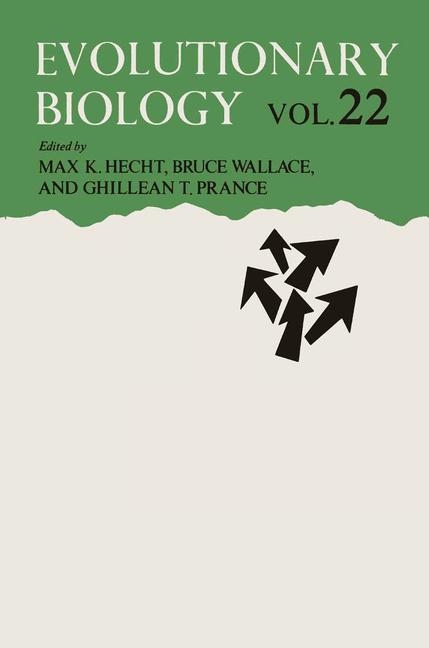
Evolutionary Biology
Kluwer Academic/Plenum Publishers (Verlag)
978-0-306-42742-8 (ISBN)
- Titel ist leider vergriffen;
keine Neuauflage - Artikel merken
1. Phylogeny of Early Vertebrate Skeletal Induction and Ossification Patterns.- Introduction: The Fossil Record.- The Vertebrate Skeleton.- The Products of Skeletogenesis.- Sites of Skeletogenesis.- Skeletal Enlargement.- Cartilage.- Bone.- Dentines and Enamel.- Skeletalization versus Calcification.- The Problem of Ontogenetic Similarity.- The Phylogenetic Basis of Investigation.- Findings.- Primitive Vertebrate Hard Tissues.- Early Vertebrate Induction Mechanisms.- Gnathostomes: Variations on a Theme.- Discussion.- Conclusions.- Appendix: Characters Related to Vertebrate Skeletogenesis.- References.- 2. A Review of the Origin of Snakes.- The Paleontological Evidence and Early Theories of Snake Origins.- The Affinities of Snakes.- The Scolecophidian Basicranium.- The Trabeculae Cranii.- The Nasal Capsule.- The Alary Process of the Prootic.- The Metotic Fissure.- The Stapedial Artery.- Adventitious Cartilage.- Epiphyses.- Distally Forked Ribs.- Limb Reduction.- The Constrictor Internus Dorsalis Group.- The Jaw Adductor Musculature.- The Hyobranchium and Throat Musculature.- The Trunk Musculature.- The Brain.- The Retina.- The Inner Ear.- The Nose and Associated Structures.- The Oral Glands.- The Thymus.- The Intestine.- The Pancreas.- The Bile Salts.- The Adrenal.- Cardiac Anatomy.- The Hemipenis.- The Chromosomes.- The Anguimorph Hypothesis.- The “Burrowing Lizards” Hypothesis.- Discussion and Conclusions.- The Classification of Snakes: Basic Divisions.- A Historical Review of Snake Classification.- A Cladogram of Snakes: Basic Divisions.- The Monophyly of the Scolecophidia.- The Monophyly of the Henophidia.- The Monophyly of the Anilioidea.- The Monophyly of the Booidea.- The Monophyly of the Caenophidia.- The Classification of Dinilysia patagonica Woodward.- Summary and Conclusions.- The Ecology of Snake Origins.- New Fossils and New Ideas.- The Hypothesis of a Burrowing Origin of Snakes.- The Ear of Snakes.- The Nose of Snakes.- The Tongue of Snakes.- The Loss of Limbs.- Cranial Kinesis in Burrowing Lizards and the Jaw Mechanics of Snakes.- The Origin of Snakes and the Rise of Mammals.- Miniaturization: A Unifying Concept.- References.- 3. Horses, the Fossil Record, and Evolution: A Current Perspective.- Fossil Horses and Evolutionary Thought.- Origin and Diversification of the Perissodactyla.- Synoptic History of Horses: The First 25 Million Years.- The Miocene: Acme of Horse Evolution.- The Last Eight Million Years of Horse Evolution.- Selected Evolutionary Principles.- Trends.- Modes.- Rates.- Mosaics.- Summary and Conclusions.- References.- 4. Historical Biogeography of the Drosophila melanogaster Species Subgroup.- Biogeographic and Ecological Evidence.- The Biogeography of the Species.- The Breeding Sites.- Unequivocal versus Equivocal Phylogenetic Relationships.- Paleobiogeographic Inferences.- Dispersal Tracks, Vicariance Biogeography, and the Refuge Theory.- Fragmentation of the African Tropical Forest and the Refuge Theory.- An Ancestor Originating from Asia.- Splitting of the Primeval Trunk into Two Branches.- The Three-Root Stage.- The Drosophila erecta—Drosophila orena Divergence May Have Occurred in the West Cameroon Mountains.- The Refuge Theory Possibly Valid for the Drosophila teissieri-Drosophila yakuba Differentiation.- The 2- to 3-MYA Rift Aridification: A Plausible “Vicariant” Event Resulting in Drosophila melanogaster and the Ancestor of the Three Drosophila simulans-like Species.- Oversea Dispersal, Founder Effect, and Speciation within the Drosophila simulans Lineage without Novel Chromosomal Rearrangements.- Three Drosophila simulans “Races”.- Equatorial Africa Is Presumably the Historic Zone of Secondary Contact between Drosophila melanogaster and Drosophila simulans.- The Northward Migration of Drosophila melanogaster: The Trans-Saharan Route.- The Northward Migration of Drosophila simulans: The Nile Route?.- Concluding Remarks and Summary.- References.- 5. Aposematism and Batesian Mimicry: Measuring Mimetic Advantage in Natural Habitats.- Some Background Information on Aposematism and Mimicry.- Studies with Captive Predators or at Feeding Stations in the Field.- Studies in Natural Habitats.- Protective Coloration Other Than Batesian Mimicry.- Batesian Mimicry: Studies on Trinidad.- A Reinterpretation of the Studies on Trinidad.- Batesian Mimicry: Studies of the Pipe Vine Swallowtail Complex in North America.- Discussion.- Future Research.- Summary.- References.- 6. Body Size, Ecological Constraints, and the Evolution of Life-History Strategies.- Body Size As a Central Feature in Life-History Patterns.- Overall Approaches.- Adaptive Significance of Changes in Body Size.- Emphasizing Growth Correlates in the Study of Life-History Patterns.- Patterns of Covariation in Life-History Traits, Body Size, and Ecological Background.- Broad Statistical Surveys.- Ecological Meanings of Trends in Life-History Patterns.- Body Size and Biotic Interactions.- Structuring of Communities and Body Size.- Insular Guilds, Competitive Release, and Changes in Body Size.- Conclusion.- Summary.- References.
| Reihe/Serie | Evolutionary Biology ; 22 |
|---|---|
| Zusatzinfo | 306 p. |
| Verlagsort | New York |
| Sprache | englisch |
| Gewicht | 590 g |
| Themenwelt | Naturwissenschaften ► Biologie ► Evolution |
| ISBN-10 | 0-306-42742-7 / 0306427427 |
| ISBN-13 | 978-0-306-42742-8 / 9780306427428 |
| Zustand | Neuware |
| Informationen gemäß Produktsicherheitsverordnung (GPSR) | |
| Haben Sie eine Frage zum Produkt? |
aus dem Bereich


